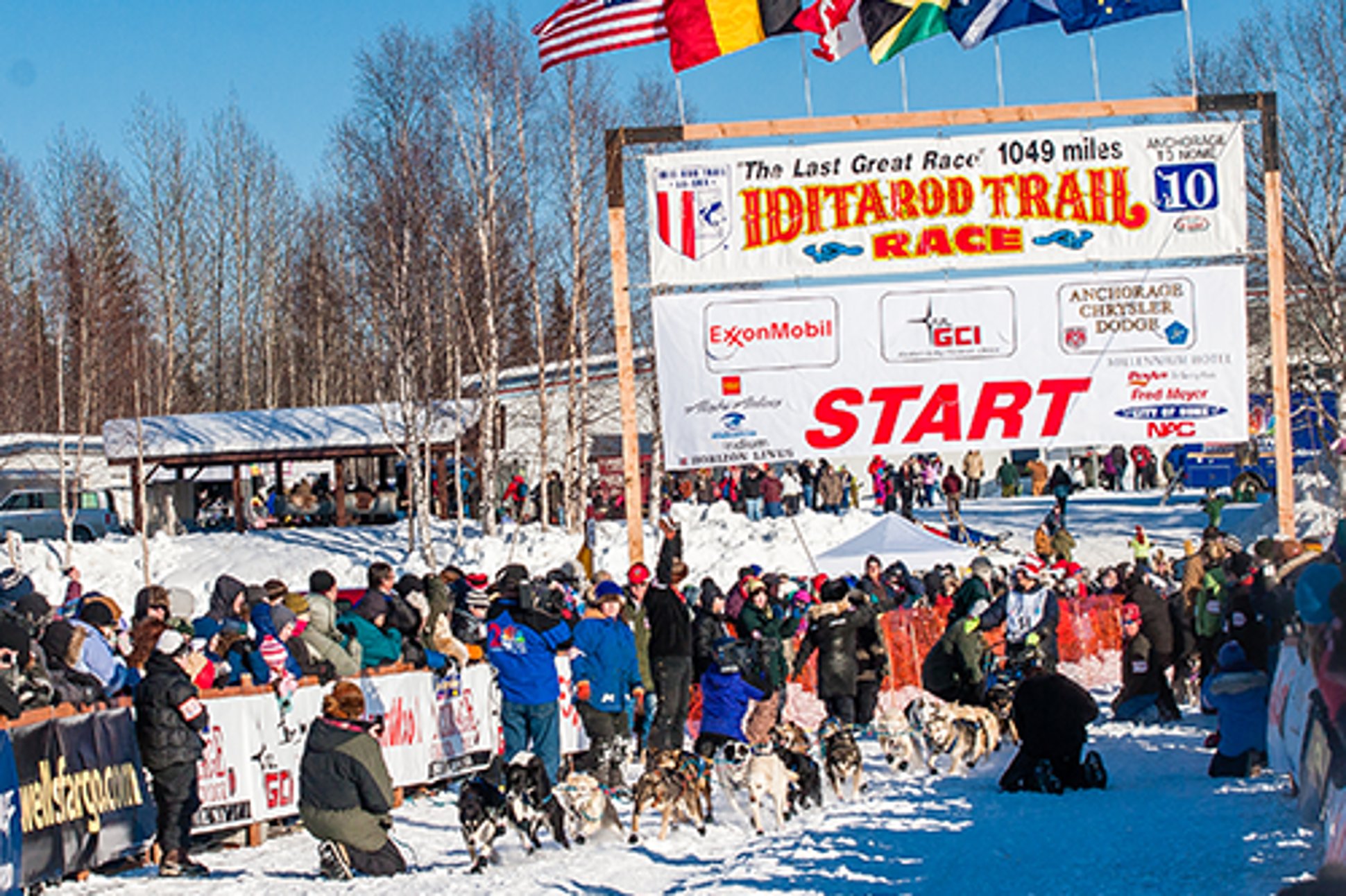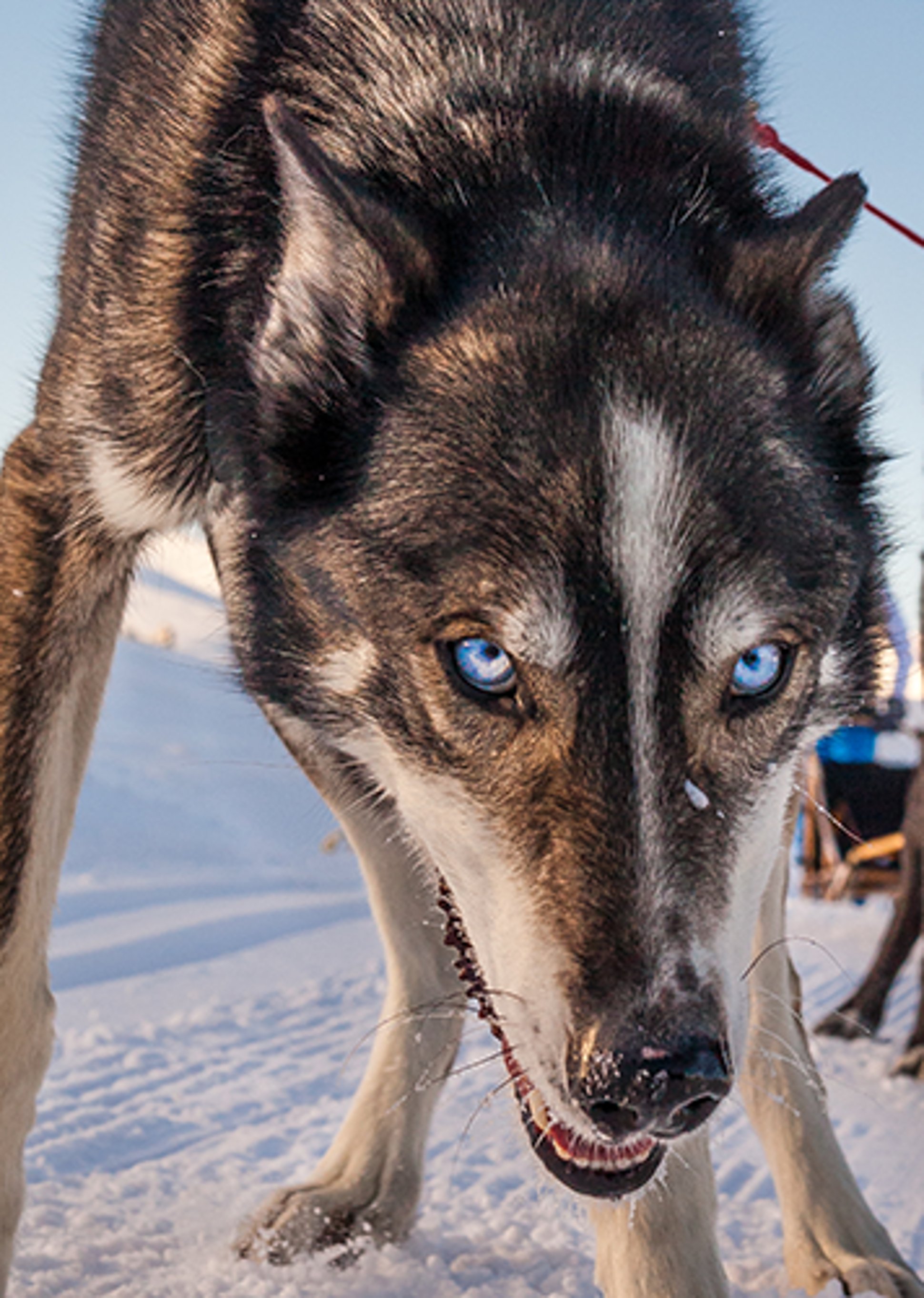A half-century ago, when the bold creation was fresh in concept but even true believers really still wondered if it could even be done, the rookie Iditarod Trail Sled Dog Race was proclaimed “The Last Great Race On Earth.”
It still is. Many times over since its debut in 1973, the Iditarod has earned that sobriquet. The length of the football field never changes. The dimensions of the baseball stadium are static. Conditions of competition in most professional sports vary little, especially those inside domed arenas. Yet the 1,000-mile challenge between Anchorage and Nome, across a forbidding land of snow and ice each March brings with it a constantly shifting playing field. Weather is the ultimate wild card, providing uniqueness, over eight, 9, 10, or more days.
Mushing 1,000 miles across Alaska in the Annual Iditarod Trail Sled Dog Race
The 50th Iditarod is scheduled to begin March 5, 2022, and four-time champion Martin Buser, 63, who is scheduled to race for the 39th time, said he could not bear to miss the anniversary race. “The reason it is the last great race is the time on the trail,” Buser says. “It’s the sleep deprivation. It’s the days of mental overload. It’s unequaled. Other events are over in relatively finite periods.”
Mark Nordman, the current race marshal, has been involved in several capacities since 1983 and is the man who ensures the planes run on time. He can say from experience, “This is the most logistically challenging event in the world.”
Many enter the race once and say, “enough.” Others compete for a quarter century before retiring. Mike Williams, 69, a musher of Inupiaq heritage from tiny Akiak, raced 15 times, ending in 2013, but said he never wanted to stop. It is not only the Alaskan cold that insinuates itself into the bones, the soul, the spirit. It is the mystery of the unexpected playing out against a backdrop of the world’s grandest scenery that stokes the excitement, not knowing whether a blizzard will swoop in from the Arctic or the hardy sled dogs will overcome obstacles to finish.
Once, race founder Joe Redington Sr. fell asleep standing on his sled runners, only to be knocked cold as his dog team ran under a low-hanging tree branch. He had to walk miles to safety. Four-time champion Susan Butcher and her team were menaced by an ornery moose that stomped dogs, forcing her to drop out. Mushers have been pinned down by 100-mile-per-hour winds and amused themselves camped out in poker games instigated by veteran Terry Atkins as they waited and waited. Sleep-deprived mushers have hallucinated about seeing polar bears on the trail. Lavon Barve, like Redington, had to adjust to a sudden life-threatening situation. Separated from his dogs, he trudged a lonely path for 18 hours in the middle of nowhere.

The Iditarod may be the stuff dreams are made of—there are constant reminders that finishing high enough in the standings means winning thousands of dollars in prize money, or merely being rewarded a finisher’s belt buckle—but the race is a feat of survival of the fittest. Those who navigate the route, part of a National Historic Trail that owes its name to the gold-rush ghost town of Iditarod, and do it well, represent a tiny percentage of those whose fantasy bucket list daringly includes giving it a try.
Champions—men and women like Buser and Butcher—are household names in the state. The Iditarod is to Alaska what the Derby is to Kentucky and the 500 is to Indiana. It is the one sporting event that unifies. The race captivates the big city of Anchorage, where the event begins with massive fanfare, Southeast, where the capital of Juneau is located, and the off-road villages. Everybody cares.
In routine conversation, winners are referred to by first names. “Jeff,” is Jeff King, a four-time titlist. Doug Swingley, then of Montana, became the first non-Alaska winner in 1995 and won four times. Lance, as in Mackey, a son of one of the race founders, Dick Mackey, is a four-time champ. Dick won the most suspenseful race in 1978, edging Rick Swenson by one second, men and dogs sprinting the final yards down Nome’s Front Street as spectators roared.
“And, of course, Libby,” Nordman says. Libby is Libby Riddles, who in 1985 became the first woman to win. A Bush dweller then, Vogue printed her picture, and the Women’s Sports Foundation named her its professional sportswoman of the year.
Periodically, the Iditarod, like all sports when milestones are reached, becomes a symbol of social change. Such was the case when the blonde Riddles became a phenomenon. The manner by which she accomplished her victory additionally endeared Riddles to admirers. A vicious storm paused racers, but rather than sit still with the boys, Riddles made the bold decision to run into it. That won her the race, and the move is considered one of the most famous gritty, competitive turning points in race history.
When Riddles was driving her dogs over the final miles into Nome, she was listening to the radio on headphones, and the song by the late balladeer Hobo Jim that is so closely identified with the race came on. “I did, I did, I did the Iditarod Trail,” are some of the lyrics. Riddles says it felt as if the tune was being played just for her.

Riddles’ unexpected victory set off a frenzy. Butcher had been second and was widely favored to become the barrier-breaking female winner. The Riddles’ win and Butcher’s following dominance inspired the T-shirt phrase, “Alaska, Where Men Are Men and Women Win the Iditarod.”
This jibe was at least generally aimed at Swenson, who previously put four championships on his resumé ahead of the others. Swenson could be blunt and did not censor his speech based on political correctness. He was sometimes dragged into minor wars of words when he offered controversial opinions essentially stating he was really the best of the bunch. Leading up to the 1991 race, Alaska Magazine published a dual cover, one side featuring Swenson, and one featuring a favored Butcher.
Once again the Iditarod’s weather and terrain trumped human predictions. In Nome, fans overfilled the bars and streets—once paved with gold it was said—now coated with ice and maybe ice cubes. Snow piled feet high outside windows as the wind howled. The same was true along the Bering Sea Coast. In White Mountain, some 77 miles and two checkpoints from the finish line, leaders, including Butcher, awaited a break in the weather.
Swenson and Buser plunged ahead. The Iditarod Air Force, which ferries supplies along the trail, was grounded. Hours passed with no word of front-runners as Nome fidgeted. It was nearly 2 a.m., about a day-and-a-half later than projected, when a musher approached Front Street, heralded by a siren. It was Swenson, frost decorating his hood and face, claiming a fifth championship. Buser came in a few hours later. It was that daring chase through minus-25-degree-temperatures with a 50-below windchill, however, that set up Buser’s future. “That was life-changing,” Buser says. “I found the will to win. I learned to win in that storm. I learned to trust myself and my dogs. It was a forging experience.”
Hugh O’Brian, the actor who played fictionalized Wyatt Earp on television, unlike the real Wyatt Earp who ran a saloon in Nome during the Gold Rush, was there to present the winner a replica pistol. Swenson asked, “Can’t we do this inside?” A darned satisfied Swenson showed manly men still populated Alaska, and it was no hallucination.

Others compiled four victories apiece, but no more. Swenson’s win record lasted unmatched for 30 years.
Dallas Seavey’s grandfather Dan was one of the pioneer mushers in 1973, finishing third. His father Mitch owns three titles. Dallas grew up in the game, winning in 2012, 2014, 2015, and 2016 before taking a break. The younger Seavey, 34, a national-caliber high school wrestler, skipped the Iditarod after becoming embroiled in a dispute with race administrators. He later received an apology for his treatment. In 2021, entrants adjusting to a COVID-19 world raced on a shortened, 938-mile, out-and-back course without spectators. Seavey overcame to equal Swenson. “I’ve dreamed of this my whole life,” says Seavey, no surprise given his lineage.
Father Mitch set the full-course record of eight days, three hours, 14 minutes, and 13 seconds in 2017 compared to the winning time in the first race of 20 days, 49 minutes, 41 seconds by Dick Wilmarth. Original mushers such as Dan Seavey, Dick Mackey, and perennial world sprint mushing champion George Attla termed the event more long camping trip than race. Mushers stopped when they tired, built fires, and told stories. Turns out the huskies really could go 1,000 miles and over time just sped up with more sophisticated training and nutritional programs.

The late Joe Redington, whose sons and grandsons have kept up the family tradition, is known as The Father of the Iditarod, although Dorothy Page conceived of a much shorter race in 1967 with the name to commemorate Alaska’s centennial purchase from Russia. Redington, who mushed 250,000 miles, established the race because he feared dog-sled history that included the life-saving diphtheria serum run of 1925, was dying out in favor of snowmobiles. At the first finishers’ meeting in Nome he declared the thousand-mile Iditarod a hit. When he asked, “Should we do it again?” he received cheers.
The Iditarod has long had a knack for inspiring. Sometimes through victories by Natives like Carl Huntington, Emmitt Peters, and John Baker, who raced on comparatively miniscule budgets with the disadvantage of living in remote areas. Then it was Riddles and Butcher, regular high finisher DeeDee Jonrowe, and others showing women possessed the outdoors savvy to handle the rigors of the trail.
Now 69, Mike Williams grew up in a family where alcoholism was rampant, and six brothers died from related reasons. Ultimately, he drafted sobriety pledges and toted pages and pages of signatures to Nome in his sled as a high-profile campaigner against the disease. He was a solid musher, but his presence raised the profile of the problem, and he became widely known and respected for his stand. Before retiring, he got to race the Iditarod alongside son Mike Jr.
“I totaled up 400,000 when I collected signatures,” Williams says. “I think it motivated me more to run for a cause. If I saved even one life, it was good enough. I had seen enough death in my own family and throughout Indian Country. I’m glad I had the chance to make an impact. It was a life-long commitment, that we must take care of ourselves.”

When Williams mushed into Native villages serving as checkpoints, Nioklai or Cripple, Ruby or Anvik, he was greeted as a hero.
Yet his favorite trail experiences are more romantic, a solo individual whooshing over the snow with his dogs surrounded by mountains, or sharing time in checkpoints with other good dog men—a solid compliment in Alaska—in years gone by like Joe Garnie, Paul Gebhardt, Tim Osmar, or Bill Cotter.
The scenery, the race challenge, the people, the places, from the hubbub of Anchorage to the coziness of villages of a few hundred citizens, added up to unparalleled adventure.
“It’s really a beautiful experience,” Williams says.

